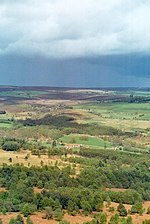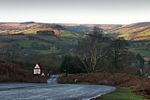Farndale

Farndale is a valley and community in North Yorkshire, England, which is known for the daffodils which flower each spring along a 7-mile (11 km) stretch of the River Dove. The valley is in the North York Moors National Park, some 11 miles (18 km) north of Kirkbymoorside, the nearest town. Pickering is some 17 miles (27 km) to the south-east and Helmsley 17 miles (27 km) to the south-west. The combined population of the civil parishes of Farndale East and Farndale West was 207 in 2011, and was estimated to have dropped to 180 by 2015.Farndale is an isolated, scattered agricultural community with traditional Yorkshire dry stone walls. The valley is popular with walkers due to its famous wild daffodils, which can be seen around Easter time all along the banks of the River Dove. To protect the daffodils the majority of Farndale north of Lowna was created a Local Nature Reserve in 1955. Farndale is home to two hamlets; Church Houses at the top of the valley and Low Mill further down. Low Mill is a tourist honeypot during daffodil season as this is where the famous daffodil walk begins. The other end of the daffodil walk is at High Mill a cluster of houses a short distance down a lane from Church Houses.
Excerpt from the Wikipedia article Farndale (License: CC BY-SA 3.0, Authors, Images).Farndale
Cross Lane,
Geographical coordinates (GPS) Address Nearby Places Show on map
Geographical coordinates (GPS)
| Latitude | Longitude |
|---|---|
| N 54.368055555556 ° | E -0.97472222222222 ° |
Address
Cross Lane
Cross Lane
YO62 7LF , Farndale East
England, United Kingdom
Open on Google Maps










